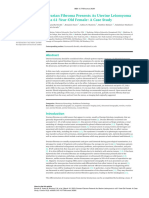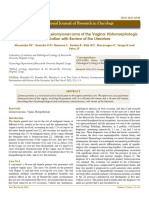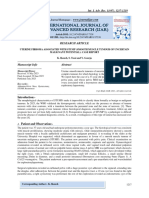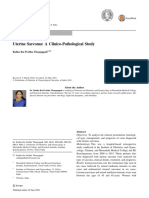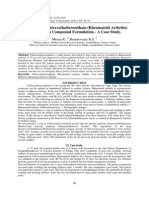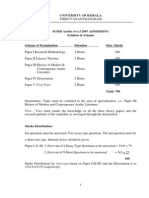IOSR Journal of Pharmacy (IOSRPHR)
IOSR Journal of Pharmacy (IOSRPHR)
Uploaded by
IOSR Journal of PharmacyCopyright:
Available Formats
IOSR Journal of Pharmacy (IOSRPHR)
IOSR Journal of Pharmacy (IOSRPHR)
Uploaded by
IOSR Journal of PharmacyCopyright
Available Formats
Share this document
Did you find this document useful?
Is this content inappropriate?
Copyright:
Available Formats
IOSR Journal of Pharmacy (IOSRPHR)
IOSR Journal of Pharmacy (IOSRPHR)
Uploaded by
IOSR Journal of PharmacyCopyright:
Available Formats
IOSR Journal Of Pharmacy (e)-ISSN: 2250-3013, (p)-ISSN: 2319-4219 Www.Iosrphr.
Org Volume 3, Issue 9 (October2013), Pp 49-52
Malignant Mixed Mullerian Tumor of the Uterus (Uterine Carcinosarcoma): A Case Report.
Dr. Siva Ranjan D. 1, Dr. J Surendar 2, Dr. Rama Swamy A S. 3, Dr. Manjunatha H K. 4,
1. Assistant Professor, Department of Pathology, Konaseema Institute of Medical Sciences and Research Foundation, Amalapuram, India. 2. Assistant Professor, Department of Forensic Medicine, Konaseema Institute of Medical Sciences and Research Foundation, Amalapuram, India. 3. Associate Professor, Department of Pathology, PES Institute of Medical Sciences and Research, Kuppam, India. 4. Associate Professor, Department of Pathology, BGS Global Institute of Medical Sciences Bangalore, India.
ABSTRACT :Malignant mixed mullerian tumors of the uterus (Uterine Carcinosarcomas) are rare and
aggressive malignancies consisting of an epithelial (carcinoma) and a mesenchymal (sarcoma) tumor component and are considered as metaplastic endometrial carcinomas. Gebhardt in 1899 appears to have reported the first case of carcinosarcoma of uterus. Carcinosarcoma though rare, representing less than 5% of all uterine tumors, account for 16.4% of all deaths caused by a uterine malignancy. Here, we present a case of 51 years old post menopausal women admitted to hospital with complaints of metrorrhagia and abdominal pain of 3 months duration. While hysterectomy with bilateral salpingo-oophorectomy remains the mainstay of treatment, high rates of recurrence, and metastasis suggests a need for lymphadenectomy and post operative adjuvant treatment.
KEYWORDS: Malignant Mixed Mullerian Tumor, Carcinosarcoma, Hysterectomy. I. INTRODUCTION
Malignant mixed mullerian tumor (MMMT) of the uterus, also known as uterine carcinosarcomas (UC) are rare and aggressive malignancies consisting of an epithelial (carcinoma) and a mesenchymal (sarcoma) tumor component associated with poor prognosis. UC predominantly occur in postmenopausal women and a higher incidence is found among black women compared with white women.[1] synonyms for carcinosarcoma in the literature include malignant mixed mullerian tumor, malignant mesodermal mixed tumor and metaplastic carcinoma. [2]
II. CASE HISTORY
A 51 year old post menopausal woman admitted to hospital with complaints of metrorrhagia and abdominal pain of 3 months duration. Additionally, her complaints were spotting, vaginal bleeding, chronic constipation and headache. Physical examination revealed slight spasm on deep palpation of lower abdomen and a sense of fullness. Vaginal examination showed a normal cervix; further gynecologic examination was not carried out for fear of precipitating further bleeding. Magnetic resonance imaging (MRI) results showed a large mass in the pelvis that entirely obliterated the architecture of the uterus with endometrial cavity distension. Preoperatively limited investigations were done and patient was posted for surgery. Total abdominal hysterectomy with bilateral salpingo-oophorectomy was done and specimen was sent to histopathological examination.
III.
PATHOLOGICAL EXAMINATION
Post-operatively we received hysterectomy specimen with bilateral fallopian tubes and ovaries separately. Specimen was fixed overnight in 10% formalin and histopathological processing was started. GROSS FEATURES: uterus with cervix measuring 12 x 6 x 4 centimeters (cm). Cut surface shows a large solitary polypoidal mass measuring 8 x 4 x 3 cm, projecting into the uterine cavity with areas of haemorrhage and necrosis.(Fig:1)
49
Malignant Mixed Mullerian Tumor
Figure 1: polypoidal mass in uterine cavity with areas of haemorrhage and necrosis. MICROSCOPIC FINDINGS: Microscopic sections studied showed endometrial glands and stromal cells which are large, many of the nuclei are hyperchromatic having macronucleoli and few bizarre mitoses are seen. At foci showed haphazard admixture of high-grade malignant epithelial and mesenchymal components; showing pleomorphism. (Fig: 2) and at places showed homologous spindle cell sarcomatous component displaying marked pleomorphism and atypical mitotic activity. (Fig: 3)
Figure 2: haphazard admixture of malignant epithelial and mesenchymal component.
Figure 3: sarcomatous component showing bizarre atypical mitotic activity.
50
Malignant Mixed Mullerian Tumor
Malignant uterine neoplasms containing both carcinomatous and sarcomatous elements are designated in the World Health Organisation (WHO) classification of uterine neoplasms as carcinosarcomas. Gebhardt in 1899 appears to have reported the first case, Meyer, after a personal examination of the slides, accepted it as authentic. [3] Carcinosarcomas representing less than 5% of all uterine tumors, account for 16.4% of all deaths caused by a uterine malignancy. [4] UC has been identified in decreasing order of frequency in the vagina, cervix, and ovary and most rarely in the fallopian tubes. [5,6,7,8] There are three main theories regarding the histogenesis of UC namely: [9,10] (1) The collision theory suggests that the carcinoma and sarcoma are two independent neoplasms. (2) The combination theory suggest that both components and derived from a single stem cell that undergoes divergent differentiation early in the evolution of the tumor. (3) The conversion theory suggests that the sarcomatous elements derive from the carcinoma during the evolution of the tumor. On exploring the literature we found that W G McCluggage named one more theory: The composition theory suggest that the spindle cell component is a pseudosarcomatous stromal reaction to the presence of the carcinoma. [11] Diagnosis of UC is most often made postoperatively by histopathological examination and Immunohistochemical (IHC) studies. Microscopically UC is composed of both epithelial and mesenchymal elements may be intermittently mixed or be seen as two distinct components. [12] The mesenchymal elements may be (a)homologous, containing cells native to the uterus including Stromal sarcoma, fibrosarcoma or leiomyosarcoma(2%) or (b) heterologous with mixed components including rhabdomyosarcoma (18%), chondrosarcoma (10%), osteosarcoma (5%) or liposarcoma (1%). [2] In our case, microscopic sections studied showed haphazardly admixed of both epithelial and mesenchymal components. The mesenchymal component showed homologous spindle cell sarcomatous component displaying marked pleomorphism and atypical mitotic activity.Several studies have found concordance of p53 staining between the carcinomatous and sarcomatous components in UC. [13,14] IHC studies have shown that both the sarcomatous and carcinomatous components often coexpress cytokeratin and vimentin. [15] In our case IHC studies showed p53 overexpression in both epithelial and mesenchymal component and also using antibodies against intermediate filaments, such as cytokeratin and vimentin, have shown positivity. To date; no national consensus guidelines have been established for the management of UC.[16] While hysterectomy with bilateral salpingo-oophorectomy remains the mainstay of treatment. Recurrences occur in over half of patients after surgical treatment, [2] high rates of recurrences and metastasis suggest a need for lymphadenectomy and post operative adjuvant treatment. In our case total abdominal hysterectomy with bilateral salpingo-oophorectomy was done; as such no recurrence was seen in our case upto one year follow up, postoperatively.
IV.
DISCUSSION
V.
CONCLUSION
To conclude UC which arise from female genital tract can have both epithelial and mesenchymal component. If epithelial component is benign and mesenchymal component is malignant then it is called as Adenosarcoma. If both epithelial component and mesenchymal component is malignant then it is called as Carcinosarcoma. UC is a rare, highly aggressive, rapidly progressive neoplasm associated with a poor prognosis.
REFERENCES
[1] [2] [3] [4] [5] [6] [7] [8] [9] [10] Brooks SE, Zhan M, Cote T, et al. Surveillance, epidemiology, and end results analysis of 2677 cases of uterine sarcoma 1989 1999. Gynecol Oncol. 2004;93:204208. S. A. El-Nashar and A. Mariani, Uterine carcinosarcoma, Clinical Obstetrics and Gynecology, vol. 54, 2, pp. 292 304, 2011. Meyer, R.: in Veit-Stoeckel, 6: 770-774, I930. J. S. Bosquet, S. A. Terstriep, W. A. Cliby et al., The impact of multi -modal therapy on survival for uterine carcinosarcomas, Gynecologic Oncology, vol. 116, no. 3, pp. 419 423, 2010. A. Ahuja, R. Safaya, G. Prakash, L. Kumar, and N. K. Shukla, Primary mixed mullerian tumor of the vaginaa case report with review of the literature, Pathology Research and Practice, vol. 207, no. 4, pp. 253 255, 2011. N. K. Sharma, J. I. Sorosky, D. Bender, M. S. Fletcher, and A. K. Sood, Malignant mixed mullerian tumor (MMMT) of the cervix, Gynecologic Oncology, vol. 97, no. 2, pp. 442445, 2005. B. B. Duman, I. O. Kara, M. Gunaldi, and V. Ercolak, Malignant mixed Mullerian tumor of the ovary with two cases and review of the literature, Archives of Gynecology and Obstetrics, vol. 283, no. 6, pp. 1363 1368, 2011. Y. M. Shen, Y. P. Xie, L. Xu et al., Malignant mixed mullerian tumor of the fallopian tube: report of two cases and review of literature, Archives of Gynecology and Obstetrics, vol. 281, no. 6, pp. 1023 1028, 2010. R. A. de Jong, H. W. Nijman, T. F. Wijbrandi, A. K. Reyners, H. M. Boezen, and H. Hollema, Molecular markers and clinical behavior of uterine carcinosarcomas: focus on the epithelial tumor component, Modern Pathology. In press. Z. Jin, S. Ogata, G. Tamura et al., Carcinosarcomas (malignant mullerian mixed tumors) of the uterus and ovary: a genetic study with special reference to histogenesis, International Journal of Gynecological Pathology, vol. 22, no. 4, pp. 368 373, 2003.
51
Malignant Mixed Mullerian Tumor
[11] [12] [13] [14] [15] [16] W.G. McCluggage, Malignant biphasic uterine tumors: carcinosarcomas or metaplastic carcinomas?. J Clin Pathol. 2002; 55:321-5. L. Brown, Pathology of uterine malignancies, Clinical Oncology, vol. 20, no. 6, pp. 433 447, 2008. Mayall F, Rutty K, Campbell F, et al. p53 immunostaining suggests that uterine carcinosarcomas are monoclonal. Histopathology 1994:24:21114. Szukala SA, Marks JR, Burchette JL, et al. Coexpression of p53 by epithelial and stromal elements in carcinosarcoma of the female genital tract: an immunohistochemical study of 19 cases. Int J Gynecol Cancer 1999;9:1316. George E, Manivel JC, Dehner LP, et al. Malignant mixed Mullerian tumors: an immunohistochemical study of 47 cases, with histogenetic considerations and clinical correlation. Hum Pathol 1991;22:215 23. A. V. Genever and S. Abdi, Can MRI predict the diagnosis of endometrial carcinosarcoma?Clinical Radiology, vol. 66, no. 7, pp. 621624, 2011.
52
You might also like
- Human Computer Interaction - MICT 731 - Richfield Graduate Institute of Technology (Pty) LTD - Johannesburg - NotesDocument9 pagesHuman Computer Interaction - MICT 731 - Richfield Graduate Institute of Technology (Pty) LTD - Johannesburg - NotesInnocent RamabokaNo ratings yet
- Talolong River in Lopez Quezon Basis For Project LILIDocument53 pagesTalolong River in Lopez Quezon Basis For Project LILIJV Villanueva0% (1)
- Mixed Müllerian Tumor of UterusDocument3 pagesMixed Müllerian Tumor of UterusInternational Journal of Innovative Science and Research TechnologyNo ratings yet
- 48 Kalpana EtalDocument3 pages48 Kalpana EtaleditorijmrhsNo ratings yet
- 2023 - Review - Uterine Sarcomas Surgical TreatmentDocument5 pages2023 - Review - Uterine Sarcomas Surgical Treatmentxuanyen16497No ratings yet
- Mucinous TumorsDocument9 pagesMucinous TumorsBadiu ElenaNo ratings yet
- Meigs' Syndrome and Pseudo-Meigs' Syndrome: Report of Four Cases and Literature ReviewsDocument6 pagesMeigs' Syndrome and Pseudo-Meigs' Syndrome: Report of Four Cases and Literature ReviewsAlfa FebriandaNo ratings yet
- A Study To Determine Association of Ovarian Morphology With Endometrial Morphology and Postmenopausal BleedingDocument7 pagesA Study To Determine Association of Ovarian Morphology With Endometrial Morphology and Postmenopausal Bleedingmadhu chaturvediNo ratings yet
- Ultrasonographic Assessment of Ovarian Endometrioma: Journal of Medical Ultrasound December 2008Document9 pagesUltrasonographic Assessment of Ovarian Endometrioma: Journal of Medical Ultrasound December 2008muhhasanalbolkiah saidNo ratings yet
- 10 1016@j Bpobgyn 2015 11 014Document17 pages10 1016@j Bpobgyn 2015 11 014Marco Julcamoro AsencioNo ratings yet
- Ectopic Mammary Tissue in The Axillary Region: A Case Report and Discussion of Diagnosis and ManagementDocument3 pagesEctopic Mammary Tissue in The Axillary Region: A Case Report and Discussion of Diagnosis and ManagementIJAR JOURNALNo ratings yet
- Primary Ovarian Malignant Mixed Mullerian Tumour: A Case ReportDocument7 pagesPrimary Ovarian Malignant Mixed Mullerian Tumour: A Case ReportIJAR JOURNALNo ratings yet
- Uterine Adenosarcoma Andadult Ovary Granulosa TumorDocument3 pagesUterine Adenosarcoma Andadult Ovary Granulosa TumorIJAR JOURNALNo ratings yet
- A Squamous Cell Carcinoma of The Uterine Cervix Recurring in The Form of An Isolated Bladder Metastasis: A Case Report and Review of The LiteratureDocument4 pagesA Squamous Cell Carcinoma of The Uterine Cervix Recurring in The Form of An Isolated Bladder Metastasis: A Case Report and Review of The LiteratureIJAR JOURNALNo ratings yet
- Ovarian Fibroma Presents As Uterine Leiomyoma in A 61-Year-Old Female A Case StudyDocument7 pagesOvarian Fibroma Presents As Uterine Leiomyoma in A 61-Year-Old Female A Case StudyBagus Tri WahyudiNo ratings yet
- Breast Carcinoma in Axillary Tail of Spence: A Rare Case ReportDocument4 pagesBreast Carcinoma in Axillary Tail of Spence: A Rare Case Reportrajesh domakuntiNo ratings yet
- Ovarian Myeloid Sarcoma, Gynecol Oncol Rep 2023Document7 pagesOvarian Myeloid Sarcoma, Gynecol Oncol Rep 2023Semir VranicNo ratings yet
- Two Cases of Primary Leiomyosarcoma of The Vagina Histomorphologic Presentation With Review of The LiteratureDocument3 pagesTwo Cases of Primary Leiomyosarcoma of The Vagina Histomorphologic Presentation With Review of The LiteratureScivision PublishersNo ratings yet
- Management Fam 1998Document5 pagesManagement Fam 1998Envhy WinaNo ratings yet
- 1 Ijdrdjun20191Document4 pages1 Ijdrdjun20191TJPRC PublicationsNo ratings yet
- 49 Kishor EtalDocument4 pages49 Kishor EtaleditorijmrhsNo ratings yet
- 245209-Article Text-588493-1-10-20230405Document7 pages245209-Article Text-588493-1-10-20230405Reza adi kurniawanNo ratings yet
- Clinical Signifcance of Intramural Metastasis As An Independent Prognostic Factor in Esophageal Squamous Cell CarcinomaDocument8 pagesClinical Signifcance of Intramural Metastasis As An Independent Prognostic Factor in Esophageal Squamous Cell CarcinomaTuân ĐìnhNo ratings yet
- 2017 Molecular carcinoSARCOMADocument14 pages2017 Molecular carcinoSARCOMAmaomaochongNo ratings yet
- Ductal Carcinoma in Situ Arising Within Breast Fibroadenoma: A Case Report and Review of The LiteratureDocument3 pagesDuctal Carcinoma in Situ Arising Within Breast Fibroadenoma: A Case Report and Review of The LiteratureIJAR JOURNALNo ratings yet
- 48 Devadass EtalDocument4 pages48 Devadass EtaleditorijmrhsNo ratings yet
- Diagnostic Biomarker Candidates Including NT5DC2 For Human Uterine Mesenchymal TumorsDocument5 pagesDiagnostic Biomarker Candidates Including NT5DC2 For Human Uterine Mesenchymal TumorsEditor IJTSRDNo ratings yet
- Intl J Gynecology Obste - 2023 - Berek - FIGO Staging of Endometrial Cancer 2023Document12 pagesIntl J Gynecology Obste - 2023 - Berek - FIGO Staging of Endometrial Cancer 2023Brînzǎ Maria-CristinaNo ratings yet
- Breast Development and Morphology - UpToDate 2023Document50 pagesBreast Development and Morphology - UpToDate 2023Giselen Toledo ValdebenitoNo ratings yet
- ManuscriptDocument5 pagesManuscriptAnisa Mulida SafitriNo ratings yet
- 1 s2.0 S1930043321006816 MainDocument5 pages1 s2.0 S1930043321006816 MainFatimah AssagafNo ratings yet
- Kurman 2013Document6 pagesKurman 2013adevanshi3399No ratings yet
- Mammary Carcinoma in A Male Cat Following Long-TerDocument9 pagesMammary Carcinoma in A Male Cat Following Long-TerJosé SilvaNo ratings yet
- Rare Peritoneal Tumour Presenting As Uterine Fibroid: Janu Mangala Kanthi, Sarala Sreedhar, Indu R. NairDocument3 pagesRare Peritoneal Tumour Presenting As Uterine Fibroid: Janu Mangala Kanthi, Sarala Sreedhar, Indu R. NairRezki WidiansyahNo ratings yet
- 1 s2.0 S1028455911001823 MainDocument6 pages1 s2.0 S1028455911001823 MainFatimah AssagafNo ratings yet
- Colonic Metastases of Endometrial Stromal Sarcoma A Case ReportDocument3 pagesColonic Metastases of Endometrial Stromal Sarcoma A Case ReportScivision PublishersNo ratings yet
- Asal CA OvarianDocument3 pagesAsal CA OvarianBenyamin Rakhmatsyah TitaleyNo ratings yet
- Fallopian Tubes - Literature Review of Anatomy and Etiology in Female InfertilityDocument4 pagesFallopian Tubes - Literature Review of Anatomy and Etiology in Female InfertilityRekha KORANGANo ratings yet
- 45syam EtalDocument3 pages45syam EtaleditorijmrhsNo ratings yet
- Leiomiosarkoma VaginaDocument4 pagesLeiomiosarkoma VaginaUci FebriNo ratings yet
- International Journal of Surgery Case ReportsDocument4 pagesInternational Journal of Surgery Case Reportsfitouri asmaNo ratings yet
- Uterine Fibroma Associated With Stump (Smooth Muscle Tumour of Uncertain Malignant Potential) : Case ReportDocument3 pagesUterine Fibroma Associated With Stump (Smooth Muscle Tumour of Uncertain Malignant Potential) : Case ReportIJAR JOURNALNo ratings yet
- Diagnosis in Oncology: UnusualaspectsofbreastcancerDocument5 pagesDiagnosis in Oncology: UnusualaspectsofbreastcancerLìzeth RamìrezNo ratings yet
- Bilateral Breast Metastases of Rectal Adenocarcinoma: Case Report and Review of The LiteratureDocument5 pagesBilateral Breast Metastases of Rectal Adenocarcinoma: Case Report and Review of The LiteratureIJAR JOURNALNo ratings yet
- Uterin Sarcoma Hallazgos Usg y RMNDocument6 pagesUterin Sarcoma Hallazgos Usg y RMNAlejandra Camacho UretaNo ratings yet
- 1 s2.0 S221026121500557X MainDocument3 pages1 s2.0 S221026121500557X MainÍch Đại Thắng PhanNo ratings yet
- Female CancersDocument7 pagesFemale CancersRaymund IdicaNo ratings yet
- Urachal Carcinoma: Clinicopathologic Features and Long-Term Outcomes of An Aggressive MalignancyDocument9 pagesUrachal Carcinoma: Clinicopathologic Features and Long-Term Outcomes of An Aggressive MalignancyDario D'AmbraNo ratings yet
- RG 232025065Document21 pagesRG 232025065rulitoss_41739No ratings yet
- Uterine Adenosarcoma Presenting As Uterine Inversion A Case StudyDocument4 pagesUterine Adenosarcoma Presenting As Uterine Inversion A Case StudyALEXANDER FRANCO CASTRILLONNo ratings yet
- European Journal of Obstetrics & Gynecology and Reproductive BiologyDocument5 pagesEuropean Journal of Obstetrics & Gynecology and Reproductive BiologyChennieWongNo ratings yet
- Ameloblastic FibrosarcomaDocument3 pagesAmeloblastic FibrosarcomaShar ThornNo ratings yet
- Case Report Aditya - Jurnal VancoverDocument6 pagesCase Report Aditya - Jurnal VancoverAditya AirlanggaNo ratings yet
- Inflammatory Myofibroblastic Tumors in The Peculiar Context of The Postpartum Case ReportDocument5 pagesInflammatory Myofibroblastic Tumors in The Peculiar Context of The Postpartum Case ReportIJAR JOURNALNo ratings yet
- Imaging of Gynecological Disease: Clinical and Ultrasound Characteristics of Uterine Sarcomas.Document49 pagesImaging of Gynecological Disease: Clinical and Ultrasound Characteristics of Uterine Sarcomas.Luke O'DayNo ratings yet
- LeiomyomaDocument3 pagesLeiomyomacandiddreamsNo ratings yet
- Imagenes Citologicas, Benignas, de MamaDocument19 pagesImagenes Citologicas, Benignas, de MamaPauloRosalesNo ratings yet
- Invasive Micropapillary Breast Carcinoma Discovered During The Investigation of Acute Respiratory Distress in A Postpartum Woman: A Case ReportDocument7 pagesInvasive Micropapillary Breast Carcinoma Discovered During The Investigation of Acute Respiratory Distress in A Postpartum Woman: A Case ReportIJAR JOURNALNo ratings yet
- MMMT CGH Fish StudyDocument10 pagesMMMT CGH Fish StudyMichael Herman ChuiNo ratings yet
- A Curious Case of Persistent Mullerian Duct Syndrome (PMDS) With Seminoma: A Report of A Rare CaseDocument6 pagesA Curious Case of Persistent Mullerian Duct Syndrome (PMDS) With Seminoma: A Report of A Rare Casecommon 9943No ratings yet
- Diagnosis of Endometrial Biopsies and Curettings: A Practical ApproachFrom EverandDiagnosis of Endometrial Biopsies and Curettings: A Practical ApproachNo ratings yet
- Salivary Gland Cancer: From Diagnosis to Tailored TreatmentFrom EverandSalivary Gland Cancer: From Diagnosis to Tailored TreatmentLisa LicitraNo ratings yet
- A Case of Allergy and Food Sensitivity: The Nasunin, Natural Color of EggplantDocument5 pagesA Case of Allergy and Food Sensitivity: The Nasunin, Natural Color of EggplantIOSR Journal of PharmacyNo ratings yet
- Sulphasalazine Induced Toxic Epidermal Necrolysis A Case ReportDocument3 pagesSulphasalazine Induced Toxic Epidermal Necrolysis A Case ReportIOSR Journal of PharmacyNo ratings yet
- Total Phenol and Antioxidant From Seed and Peel of Ripe and Unripe of Indonesian Sugar Apple (Annona Squamosa L.) Extracted With Various SolventsDocument6 pagesTotal Phenol and Antioxidant From Seed and Peel of Ripe and Unripe of Indonesian Sugar Apple (Annona Squamosa L.) Extracted With Various SolventsIOSR Journal of PharmacyNo ratings yet
- A Review On Step-by-Step Analytical Method ValidationDocument13 pagesA Review On Step-by-Step Analytical Method ValidationIOSR Journal of Pharmacy100% (1)
- A Review On Step-by-Step Analytical Method ValidationDocument13 pagesA Review On Step-by-Step Analytical Method ValidationIOSR Journal of Pharmacy100% (1)
- Treatment of Uthiravatha Suronitham (Rheumatoid Arthritis) With A Siddha Compound Formulation - A Case Study.Document3 pagesTreatment of Uthiravatha Suronitham (Rheumatoid Arthritis) With A Siddha Compound Formulation - A Case Study.IOSR Journal of Pharmacy100% (1)
- Phytochemical Screening and Antioxidant Activity of Clove Mistletoe Leaf Extracts (Dendrophthoe Pentandra (L.) Miq)Document6 pagesPhytochemical Screening and Antioxidant Activity of Clove Mistletoe Leaf Extracts (Dendrophthoe Pentandra (L.) Miq)IOSR Journal of PharmacyNo ratings yet
- Sex TractorDocument44 pagesSex TractorgramireztNo ratings yet
- A Detailed Lesson Plan in Mathematics For Grade 8 Linear Equations in Two VariablesDocument6 pagesA Detailed Lesson Plan in Mathematics For Grade 8 Linear Equations in Two VariablesIan Santos Salinas100% (1)
- Test 4 - 26022024Document2 pagesTest 4 - 26022024Thanh ThảoNo ratings yet
- Review PaperDocument4 pagesReview PaperBasit MurtazaNo ratings yet
- A Feminist AnalysisDocument9 pagesA Feminist AnalysisChikay Ko Ui100% (2)
- Peac Documentation Checklist: Folder A: School Philosophy, Vision, Mission, Goals/Objectives Exhibits/DocumentsDocument3 pagesPeac Documentation Checklist: Folder A: School Philosophy, Vision, Mission, Goals/Objectives Exhibits/DocumentsMark Charle Mana100% (3)
- Unit 1 Health Care Information Regulations, Laws and StandardsDocument59 pagesUnit 1 Health Care Information Regulations, Laws and StandardsALEXANDRA MARIE BUNQUIN100% (1)
- Documents: Convert Powerpoint Files in PDF! W/ The Free PDF Converter For PCDocument15 pagesDocuments: Convert Powerpoint Files in PDF! W/ The Free PDF Converter For PCpetreNo ratings yet
- Oracle Strategic Workforce Planning Cloud (HCMSWP)Document10 pagesOracle Strategic Workforce Planning Cloud (HCMSWP)Amit SharmaNo ratings yet
- Open VasDocument8 pagesOpen VasAlfa FoxtroxNo ratings yet
- 1066103Document39 pages1066103Johnniequest Queens BestNo ratings yet
- 3DMM CSWP 027Document1 page3DMM CSWP 027mlik borhen100% (1)
- HypnosisDocument17 pagesHypnosisDave_SadvertfileNo ratings yet
- Sap Ehp1 For Sap CRM 7.0: Learning Map For Partner Channel Management ConsultantsDocument8 pagesSap Ehp1 For Sap CRM 7.0: Learning Map For Partner Channel Management ConsultantskalyansapcrmNo ratings yet
- A Sentence Is An Idea, A Paragraph Is Closely Related Ideas: 1,000 Words Paragraphs Easy ParagraphsDocument4 pagesA Sentence Is An Idea, A Paragraph Is Closely Related Ideas: 1,000 Words Paragraphs Easy ParagraphsramNo ratings yet
- Analyzing Time-Varying Noise Properties With SpectrerfDocument22 pagesAnalyzing Time-Varying Noise Properties With Spectrerffrostyfoley100% (1)
- Aict004!3!2 Os Group Assignment Ucd2f1204dit (Se) Ucd2f1204ditDocument4 pagesAict004!3!2 Os Group Assignment Ucd2f1204dit (Se) Ucd2f1204ditSathya SeelanNo ratings yet
- Brown, M. Listening TeachersDocument14 pagesBrown, M. Listening Teachers46410No ratings yet
- Ajax Imp CodesDocument51 pagesAjax Imp Codessatyanarayana100% (2)
- Science, A Blessing or CurseDocument4 pagesScience, A Blessing or CurseAhmad NaeemNo ratings yet
- GPR Import DisplayDocument2 pagesGPR Import DisplayAlexandra GereaNo ratings yet
- Conceptual Marketing Framework For Online Hotel Reservation System DesignDocument42 pagesConceptual Marketing Framework For Online Hotel Reservation System DesignStanislav Ivanov100% (1)
- Application of GeogridDocument5 pagesApplication of GeogridNabeel AL-HakeemNo ratings yet
- M.Phil Arabic Syllabus at Kerala UniversityDocument5 pagesM.Phil Arabic Syllabus at Kerala Universitythajudeenmannani100% (1)
- Smart Water Monitoring System: BY Shanmuga Ashwinth Shylesh Raghul Kiranniketh C Iii - Mca (B1)Document7 pagesSmart Water Monitoring System: BY Shanmuga Ashwinth Shylesh Raghul Kiranniketh C Iii - Mca (B1)Kiranniketh CNo ratings yet
- Glasgow City Council - STR Calc GuidanceDocument2 pagesGlasgow City Council - STR Calc GuidanceMichael KilpatrickNo ratings yet
- PPM - SyllabusDocument13 pagesPPM - SyllabusJoseph Kanyi King'ori - HonNo ratings yet














